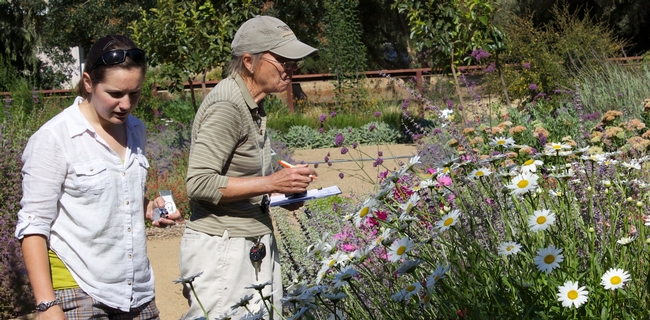- Author: Christine Casey
We held a volunteer work day at the Haven this past Saturday, November 1; the much-needed rain cleared out in time to leave us with a beautiful day. Tremendous thanks go to Mohammad-Amir Aghaee, Danny Klittich, Eric Mussen, and Robbin Thorp from the UC Davis Department of Entomology and Nematology and to Honey Bee Haven volunteers Kataksha Kinra, Emily Kultgen, Lynda Ives, Tobias Mueller, Kirsten Pearsons, Erik Sandberg, and Linda Watson-McMurdie. New volunteers are always welcome; see our web site for more information.
New plants were added and mulched, less productive plants were cleared out, and irrigation repairs were made. Thanks to everyone who helped out to keep the Haven a special place!




- Author: Christine Casey
Ask most folks about "fall color" and they'll picture trees turning shades of red, orange, and yellow. Here at the Haven, on the other hand, we think about all the plants that will bloom until frost. These provide honey bees with critical late-season honey-making resources; other bees and butterflies use these late bloomers as well.
I wrote about fall planting a few weeks ago. Here are some recent photos from the garden showing our version of "fall color."
Asters
Although they still go by the common name of aster, the New World plants in this group are now in the genus Symphyotrichum. Here's one of the largest, Symphyotrichum 'Bill's Big Blue' with many honey bees working its flowers. 'Bill' is a big guy, so be sure to give him plenty of room to spread and sprawl.

Ceanothus

Sunflowers

Zinnias
Pretty, easy-to-grow, and great for bees. What more could you want in a flower? We sow zinnia seeds directly into the garden. Do this in May for summer bloom and again in August for blooms that will go until frost.

- Author: Kirsten Pearsons
This summer I have had the joy of being an intern at the Honey Bee Haven. It seems quite unfair that many students were taking summer classes or holed up in labs while I got to be outside working in a beautiful garden!
If you have visited the garden recently, you will have noticed the multitude of new plants signs. Updating the signs has been a summer-long project that started during my first week at the Haven. Back in June, Chris showed me around the garden and had me take notes on what plant signs we needed to add to the garden. I come from a botanical background, so I thought I knew plants, yet I found myself having trouble connecting the plants in the garden to the plant names I recognized.
In the following weeks, I worked with and among the garden's 250-plus plants, I researched the best bee-friendly plant families, and I drew and painted dozens of flowers for Haven displays. The time flew by and soon enough it was the end of September - time to finish updating and replacing the plant labels. By then, I could easily recognized most of the plant families and individual species. As Chris and I placed signs throughout the garden, I was also reminded of the things I had seen and done throughout the summer. The shasta daisies, yarrows, california buckwheat, and gum plant had become my constant companions through the our survey of natural enemies; the catmint, calamint, and cape balsam were buzzing with honeybees as they had been all summer; and the zinnias were busier than ever with visits from honeybees, native bees, skipper butterflies, and gulf fritillary butterflies.
While I will take away many things from this experience – a special fondness for mantids, an appreciation for combining art and science, and a much greater knowledge of plant and bee biology – my greatest take away will be the genuine interest and excitement of the people that I met in the garden. All garden guests, energetic children to master gardeners, were always happy to learn something new and share their garden experience. The garden is a wonderful place to let your imagination run wild whether you're seeking out cool critters or new garden ideas.
Overall, I have come to realize that, to be a good gardener you have to understand and appreciate insects, and to be a good entomologist you have to understand and appreciate plants. So being a gardening entomologist certainly has its advantages!


- Author: Christine Casey
Thanks to all who made the final Honey Bee Haven open house of 2014 a success! Visitors had the chance to view pinned specimens and live bees in the garden, as well as in the observation honey bee hive. Several folks purchased bee houses, and three lucky raffle winners went home with plants or a copy of the newly published California Bees and Blooms.
From the UC Davis Department of Entomology and Nematology, thanks go to bee biologists Bernardo Nino, Elina Nino, and Billy Synk, administrative staffer Maria Tuccori, and garden intern Kirsten Pearsons. Garden volunteers who helped include Emily Kultgen, Stephanie Macey-Gallow, and Kelly McKee.
- Author: Christine Casey
Here at the Haven we're all about providing ideas to make bee gardening easy. We just want you to do it! One simple way to create a bee garden is to plant an herb garden. Not only will you help the bees, you'll have fresh herbs for cooking the food that bee pollination has provided. Let your herbs flower and you're all set; cut the flowers off as they fade to ensure repeat bloom. An added benefit is that many common Mediterranean-climate herbs are fairly low water users.
While herbs generally bloom in the summer and early fall, rosemary and borage bloom in the winter and early spring, respectively. Include these in your bee herb garden to maximize the resources you are providing. Herbs currently flowering at the Haven include basil, oregano, catnip, calamint, and rosemary.







